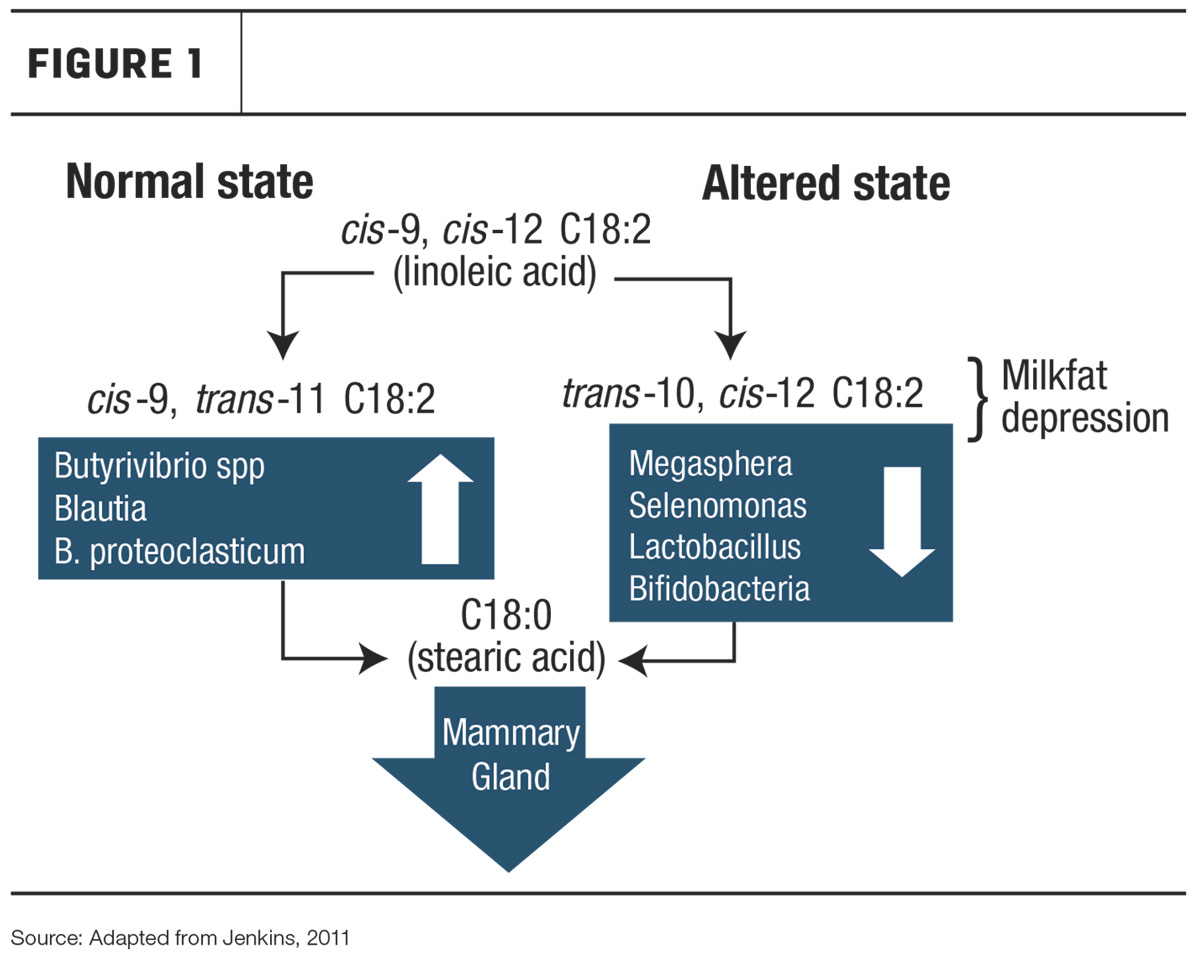Due to record highs for butterfat pricing, the buzz in the industry has been about how to maximize butterfat production in the bulk tank. But at the end of the day, it’s the individual cows that are being milked into the bulk tank and eating the rations. Each cow has a different routine and genetics and is influenced by her environment differently. Currently, it is difficult to target individual cows within a pen. Nutritionists aim for an above-average cow and try to keep increasing the overall average by increasing the pen’s production values.
However, it is not just nutrition that influences milkfat. Milkfat amount (percentages or yield) is driven by many variables that are both nutritional and non-nutritional. Non-nutritional factors include genetics, breed, season of the year and physiological state. Non-nutritional factors are long-term projects that impact milkfat. Some nutritional factors are the amount of fiber in the ration, types of feed ingredients used, the presence or absence of ionophores and the type of feeding strategy on-farm. These factors not only have short-term impact on milkfat production but also can have long-term influences.
While dairy farmers cannot easily control all the factors that influence milkfat, one they can minimize is the occurrence of milkfat depression. Milkfat depression is a condition in which fat yield decreases up to 50% with generally no change in milk yield or other component yields. Nutritional milkfat depression is observed in dairy herds that feed a highly fermentable ration or a ration high in plant oils. These rations lead to a change in the rumen environment that typically includes a lowering of rumen pH and a decrease in acetate-to-propionate molar ratio, which decreases the amount of acetate (a volatile fatty acid produced by rumen microbes) that is required to produce milkfat. While it is difficult to predict how cows will react to a new ration, there are risk factors that can increase the probability of milkfat depression, including: increased diet fermentability, increased polyunsaturated fatty acids, lack of rumen modifiers and slug feeding.
The goal is to maintain as much ruminal production through the normal state of biohydrogenation as possible. Ruminal biohydrogenation is the way the rumen assists in creating fatty acids that are fully saturated. Saturated fatty acids can be taken up by the mammary gland (the udder) for milkfat production. There are two pathways whereby the rumen can create fatty acids for milk production. For both pathways, the starting material is linoleic acid (C18:2), a polyunsaturated fatty acid.
Through the normal rumen state, linoleic acid gets converted to cis-9, trans-11 C18:2, then to trans-11 C18:1 and ultimately to stearic acid (C18:0). The altered state transforms linoleic acid into trans-10, cis-12 C18:2, then to trans-10 C18:1 and ultimately stearic acid (C18:0). What’s the difference? Just a few numbers in a fatty acid name, but the physiological difference of these two pathways is huge for the cow.
While both pathways reach the same end point of stearic acid, increased levels of the trans-10, cis-12 C18:2 fatty acid are considered potent inhibitors of milkfat synthesis and will quickly induce milkfat depression. By maintaining the normal state of ruminal biohydrogenation through the cis-9, trans-11 C18:2 fatty acid, a cow’s butterfat production will be maintained at a higher level compared to the trans-10, cis-12 C18:2 fatty acid pathway (Figure 1). So how do you optimize the normal, better state of milkfat production?

Contemporary rations fed to dairy cows tend to push the edge of production and will typically include plant oil, or increased carbohydrate fermentability, which can induce milkfat depression. So, is there a product that can help decrease the risk of contemporary rations inducing milkfat depression?
At universities, there are specific rations used to induce milkfat depression using two risk factors: increasing unsaturated fatty acids and increasing carbohydrate fermentability. While using these rations in trials, a form of methionine, 2-Hydroxy-4-(methylthio)butanoate (HMTBa), has been found to maximize milkfat as a percentage and total milkfat yield, even when at risk for milkfat depression.
This research shows that cows fed HMTBa have decreased amounts of trans-10 C18:1, which supports the theory that HMTBa is able to stabilize the microbiota so there isn’t a shift toward the altered (poor) state in the rumen, and the normal (better) pathway persists. HMTBa has also been shown to stabilize the diversity and types of microbes in cows when fed a ration that should induce milkfat depression.
While HMTBa is not the only product that will encourage milkfat production, it is another tool to be utilized so dairy farmers can maximize their butterfat production.
References omitted but are available upon request. Click here to email an editor.







